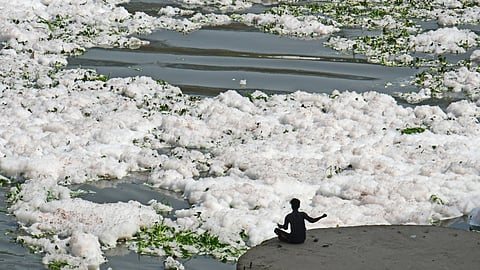

NEW DELHI: In the heart of India’s capital, hundreds of illegal jeans dyeing units are quietly damaging capital’s water resources and environment. These dyeing units are reportedly consuming nearly 100 million litres of water each day and dumping chemical-laden waste directly into the capital’s drainage system, which ultimately merges with the Yamuna River.
This environmental disaster continues unchecked, even as residents suffer chronic water shortages during the sweltering summer months. Every summer, long queues form across Delhi as people wait for water tankers to meet their basic needs. Meanwhile, thousands of litres of clean groundwater are used daily by jeans and textile dyeing units operating in violation of environmental laws. Experts say the textile industry—including dyeing, bleaching, and printing—is classified as a “red-category” industry due to its high pollution levels.
Legally, such units must obtain approvals under the Water Act of 1974, the Air Act of 1981, and the Hazardous Waste Rules, but many simply ignore the rules. Despite these requirements, hundreds of units operate illegally, openly violating norms. What’s worse, many function from within residential neighbourhoods.
A recent on-ground visit revealed shocking scenes in parts of Delhi. In Seelampur and Sonia Vihar Pushta-1, for example, drains overflowed with blue-tinted water from dyeing factories. The foul-smelling wastewater spilled onto streets, making life miserable for residents.
Suresh Jha, a local, said these units have been operating for over two decades. “Everyone knows they’re here. Officials are paid off every month. If we complain, we get threats. Even the police ignore us,” he said.
In Seelampur, dozens of illegal units operate in plain sight. Fabrics are dried on rooftops, visible even from passing metro trains. Residents say local drains and roads have been contaminated with untreated wastewater flowing directly into the Yamuna. “We’ve been suffering for years. The water is poisoned, and many of us have health issues now,” said Mustaq, another resident. “When we raise our voices, we’re either threatened or ignored. No one helps.”
Environmental activist Varun Gulati said the problem extends beyond a few pockets. “Illegal dyeing units are active across Delhi—in Bindapur, Matiala, Khyala, Meethapur, Mukundpur, Bawana, Badli, Mayapuri, Ghazipur, Sarita Vihar, and more.”
Each unit consumes 200,000–500,000 litres of groundwater daily. Since they can’t apply for legal water connections without exposing themselves, they rely on illegal borewells. In total, these units use nearly 100 million litres daily—enough to meet the water needs of thousands of homes.
Worse still, none of the wastewater is treated before discharge. These units release toxic substances like lead, cadmium, arsenic, and zinc into stormwater drains. These drains are designed only for rainwater—not industrial waste—making the situation more dangerous.
Though the newly elected BJP-led Delhi government has promised to clean the Yamuna by ensuring the flow of clean water, experts believe illegal dyeing units are undermining the effort.
“No matter how much the Delhi Jal Board upgrades sewage treatment plants, it won’t help if untreated chemical waste keeps entering the river. STPs are meant for household sewage, not industrial chemicals,” Gulati warned.
In fact, polluted water entering STPs can damage them, reducing their efficiency. “If these factories aren’t shut, the Yamuna will never be clean,” he added.
The Delhi Pollution Control Committee (DPCC) had earlier forwarded the issue to the Municipal Corporation of Delhi. A DPCC official, speaking anonymously, said a report on illegal units is being prepared for the National Green Tribunal. While some units were shut, the practice continues.
Earlier this year, the NGT was informed that action had been taken in Meethapur and Khyala. But activists said many factories in those areas were still running. The NGT then asked DPCC to intensify its crackdown and submit a fresh report within four weeks. Environmentalists warn that unchecked dyeing waste is destroying Yamuna’s biodiversity. “Toxic chemicals from these factories are killing fish, birds, and aquatic plants. Oxygen levels have dropped so low that even hardy species are dying,” said Manoj Kumar, a Noida-based activist.
“Once home to migratory birds and native fish, the Yamuna is now barren. Polluted water makes it impossible for fish to breed. If we don’t act soon, it’ll become a dead river,” Kumar added.
The Delhi Jal Board recently presented a comprehensive action plan to newly elected CM Rekha Gupta. The plan includes desilting major sewer lines, improving drainage, and upgrading four key sewage treatment plants. DJB operates 37 such plants and is expanding capacity in Rithala, Rohini, and Narela.
A senior DJB official said the Chief Minister has shown full support and promised to address funding gaps. “Our main aim is to stop untreated waste from reaching the Yamuna,” the official said.
But experts remain sceptical. Gulati said technological upgrades alone won’t solve the problem. “Illegal dyeing units are the real culprits. Unless they’re shut, no amount of tech will fix this.”
He also alleged that MCD officials often alert factory owners ahead of inspections. “It’s a scam. The Supreme Court and NGT have both ordered action, but nothing serious is being done,” he said.
Delhi’s water crisis is worsening each year. While the government talks about expanding treatment capacity and fixing drainage systems, the core problem—illegal dyeing units—remains largely ignored. Environmentalists and residents are calling for immediate and strict action. They want heavy fines, legal enforcement and factory shutdowns. Without this, experts warn, efforts to revive the Yamuna will fail.